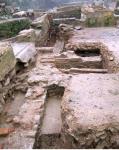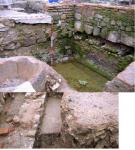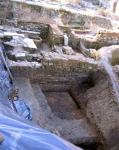Summary (English)
PHILIPPOPOLIS (Zheni Tankova – RAM.Plovdiv@gmail.com) The site covered an area of 7650 sq. m and was located under the southern slopes of Trimontium, close to the Roman forum, stadium and theater. Sectors of two decumani, two cardines and six adjacent insulae are discovered so far. A fortification wall dated after AD 550 was discovered across the site as well. In 2014, 13 rooms from the 1st – first half of the 3rd centuries AD were explored in Insula No. 5. Their walls were 60 – 65 cm wide, built of ashlars bonded with mortar and of mortared stones, with upper parts constructed of sun-dried bricks. Room No. 8 had an area of 48 sq. m and its walls were covered with red plaster and its floor was plastered with mortar. A pedestal with a fragmentary altar in situ was discovered in another room and seven bronze appliqués were found nearby. The building had a water conduit of lead pipes and a second water conduit of terracotta pipes. The drains were constructed of bricks and lead towards Decumanus No. 2. The finds included sherds, terracotta lamps and coins. The building was burned during the Gothic invasion in the middle of the 3rd century AD. A layer with burned sun-dried bricks and fragmentary tegulae and imbrices, 50 – 70 cm thick, was documented. During the second occupation period from the second half of the 3rd to the first half of the 5th centuries AD the structures from the first period were reused, while 11 rooms were constructed in opus mixtum. Room No. 5 measured 12 m by 8 m and had a floor plastered with mortar and four entrances. A latrine and a urinal were discovered in Room No. 11. During the third occupation period in the second half of the 5th – 6th centuries AD the structures from the second period were reused. The construction technique and the layout of the building remained the same.
- Zheni Tankova - Archaeological Museum – Plovdiv
Director
Team
Research Body
- Archaeological Museum – Plovdiv






![Download [PDF]](/excavation/skins/fasti/images/results/download_sml.png)

